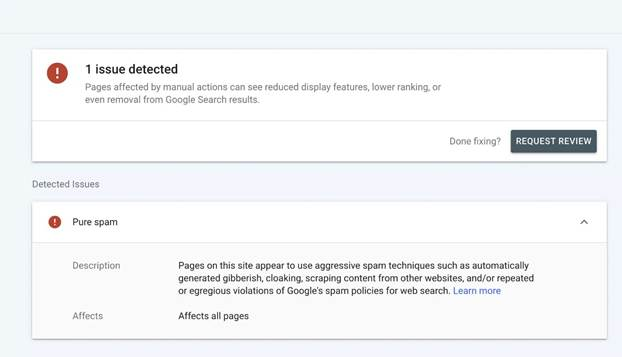A Peeved Business Owner’s Guide to Google Penalties
-

Jonas Trinidad
- Blogs
-
 October 29 , 2025
October 29 , 2025 -
 8 min read
8 min read
“If SEO isn’t driving you crazy, you’re probably doing it wrong.”
That’s how I sum up my experiences working in the industry for almost a decade. One day I’m stuffing as many keywords as possible in an article or blog post, the next day the Big G decides that it’s spam. And yes, I wasn’t above practices that are now considered black-hat SEO—it was the norm back then.
It isn’t just industry experts who are getting annoyed. Online forums are filled to the brim with business owners who have had enough of Google’s tight-lipped policy on details of its search engine algorithm and sweeping core updates. Even if they follow its content rules to the letter, ranking at the top of organic results is still a hit or miss.
Because of this, some businesses try to fool the algorithm into ranking them high on the search engine results pages (SERPs). Whether or not they manage to pull it off, they can expect Google to come for them eventually—with grave consequences.
Punishing Black Hats
Google employs a three-step system that filters web spam. It claims that the system goes through tens or hundreds of billions of spammy pages daily. (1)

Search crawlers are its primary means of detecting spam. Before indexing or including a page in search results, they analyze the content for violations of Google’s search quality guidelines (known as Google Search Essentials). If they find one, they slap the offending page with an algorithmic or automatic penalty, which can be:
- Demotion: The page drops in rankings, which affects its visibility in SERPs and even incoming traffic. How much the ranking drops depends on multiple factors, but you can expect it to be nowhere close to the top 10.
- Deindexing: Typically reserved for more severe violations, this penalty removes the page from SERPs. While the page can still be accessed (by knowing the exact URL), users won’t be able to find it when searching on Google.
The less than 1% of spam that manages to slip past the automatic net undergoes a manual review done by Google’s team of human evaluators. Using their deep understanding of the guidelines and sound judgment, they slap offending pages with a manual penalty.
There is no concrete way to determine if your page has been hit with an automatic penalty. A common approach involves assessing the page’s recent traffic numbers. An unusual dip in traffic can signify such a penalty.
Fortunately, that isn’t the case for a manual penalty. The team will send the site owner a notice via the Google Search Console, which looks like this:

Source: Search Engine Land
Automatic penalties don’t appear on the Manual Actions report.
Reasons for Getting Penalized
Exact numbers showing the effects of Google penalties on businesses are hard to come by. Part of the reason is that the company doesn’t publicly disclose relevant statistics. A look into the few numbers that are already published reveals that they either come from outdated sources or rough estimates.
Nevertheless, the risks of a penalty are real. DataReportal discovered last year that Google ranks as the most visited website on the Web in terms of total and unique visitor counts. Based on data from SimilarWeb and SEMrush, it gets a monthly average of between 83.1 and 131 billion total visits and 3.21 and 6.06 billion unique visitors. (2)
Getting deindexed from the Internet’s largest search engine effectively denies a website a major source of organic traffic. A ranking drop is less serious but can still be crippling due to the fact that most users expect answers within the top 10 results, if not the top-ranked. Either way, a business will be restricted in its ability to grow its customer base.
The following violations can result in a manual action from Google: (3)
| Reason for Penalty | Description | What’s Affected* | |
| Page/s | Entire Site | ||
| Third-party spam | General spam content that goes against the guidelines and is generated by third parties, such as visitors | ✅ | X |
| User-generated spam | Spam content left by users, such as spammy posts and post replies or multiple user accounts made for spam | ✅ | X |
| Spammy free host | Websites or pages hosted by a single free web hosting service are chock-full of spam content | ✅ | ✅ |
| Structured data issue | Umbrella term for various related techniques that go against Google’s rules on creating structured data | X | ✅ |
| Unnatural links | Links and link schemes that go against Google’s spam policies (whether inbound or outbound) | ✅ | ✅ |
| Thin content | Content that adds little to no value to a user’s search experience (e.g., scraped content, doorway abuse) | ✅ | ✅ |
| Cloaking and/or sneaky redirects | The link leads visitors and crawlers to a different site from the one that’s initially advertised | ✅ | ✅ |
| Major spam problems | Refers to aggressive spam techniques such as scaled content abuse or repeated guideline violations | X | ✅ |
| Cloaked image | Misleads search engines by providing a different image from the one viewed by the site’s visitors | X | ✅ |
| Hidden text and/or keyword stuffing | Hiding text or mentioning keywords repeatedly in an effort to manipulate the search engine algorithm | ✅ | ✅ |
| AMP content mismatch | The accelerated mobile page (AMP) version of the website is vastly different from the normal one | X | ✅ |
| Sneaky mobile redirect | A sneaky redirect where the mobile version of a website is different from its desktop counterpart | X | ✅ |
| News and Discover policy violations | Content that goes against content policies for Google News and Discover (e.g., hate or misleading content) | ✅ | X |
| Site reputation abuse | Taking advantage of third-party content’s already-built reputation to boost the host website’s own | ✅ | ✅ |
*Under normal circumstances. Google may opt for a different course of action depending on the nature of the case, hence the need for human judgment.
On the other hand, algorithmic penalties follow the code introduced to the algorithm via minor and major updates. While blatant violations can trigger them, so can newly rolled-out updates. In the latter’s case, Google advises against taking any drastic action if your content drops by no more than four ranks, as it may rebound later. (4)
One more thing: the site owner is still liable for violations caused by cyberattacks. Take the time to clean up the mess left by hackers and invest in advanced security measures to stop it from happening again.
Repair and Reconsideration
If you see a Manual Action report in the Search Console, the obvious solution is to manage it as soon as possible. This penalty will remain until the violation has been resolved on all affected pages. While doing so, make sure the pages are crawlable (unless you intend the page to be non-crawlable at all).
Ensuring crawlability is crucial because resolving all the issues won’t automatically restore your page’s SERP ranking. To lift the penalty, the site owner needs to file a reconsideration request with Google’s web spam team. Creating one is similar to writing a formal letter—a really long one, in fact, as it should ideally contain:
- Details of the Manual Action penalty, including the hit pages
- Steps taken on your side to address the guideline violations
- Results of taking said steps, preferably in detail
- Steps to take to prevent the issues from recurring
- Supporting documents, preferably uploaded to Google Docs
As human evaluators are in charge of reviewing said requests, expect the process to last several days or weeks. Link-related requests can take a lot longer. (3)
It pays to be honest and polite when writing your request. Throwing a fit on the Big G won’t help, let alone faking your resolutions to have them lift the penalty. Remember that Google has sophisticated tools that can help spot lies from miles away.
Avoid sending a reconsideration request for just one Manual Action penalty. Google only needs one that covers all the penalties. Additionally, resist the urge to follow up on your request; it won’t make the process go any faster.
Note that this doesn’t apply to algorithmic penalties. Fortunately, fixing the issues as per Google’s guidelines should prompt the algorithm to restore a page’s ranking much faster than waiting for a human team’s response.
A Google Penalty Isn’t the End of the World
Recovering from a Google penalty boils down to how willing a business is to make things right. While ranting about it may offer some relief, taking the opportunity to manage SEO issues can result in long-term success.
References:
1. How we fought Search spam on Google in 2020 | Google Search Central Blog [Internet]. Google for Developers. Available from:https://developers.google.com/search/blog/2021/04/how-we-fought-search-spam-2020
2. Kemp S. Digital 2024 October Global Statshot Report [Internet]. DataReportal. 2024. Available from:https://datareportal.com/reports/digital-2024-october-global-statshot
3. Manual Actions report – Search Console Help [Internet]. Google.com. 2019 [cited 2025 Aug 4]. Available from:https://support.google.com/webmasters/answer/9044175#zippy=
4. Google Search’s Core Updates | Google Search Central | What’s new [Internet]. Google Developers. Available from:https://developers.google.com/search/updates/core-updates
Subscribe to Our Blog
Stay up to date with the latest marketing, sales, service tips and news.
Sign Up
"*" indicates required fields


